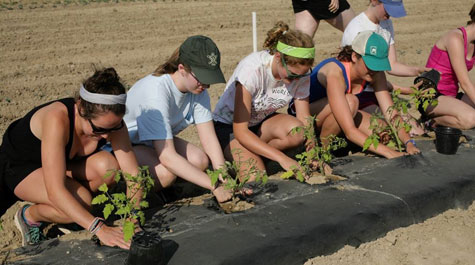W&M unveils Climate Action Roadmap guide to a greener future
William & Mary has rolled out the Climate Action Roadmap portion of its Sustainability Plan, officials announced today.
The nine-year roadmap sets out specific suggestions in key areas of the university’s multi-pronged approach to a more sustainable future.
“The Climate Action Roadmap outlines key steps towards a sustainable university,” said President Katherine A. Rowe. “The roadmap charts a course for net carbon neutrality, interdisciplinary scholarship and teaching, and operating initiatives that will guide the university’s new strategic plan.”
Rowe launched W&M’s first long-range, comprehensive Sustainability Plan in 2019. Progress that university departments have made includes that 50% of W&M’s electricity will come from a local solar farm starting next year, creation of a sustainable living guide, expansion of community composting bins and the identification of local and green catering offerings, according to Director of Sustainability and Co-Chair of the Committee on Sustainability Calandra Waters Lake.
The Sustainability Plan included a commitment to establish an ambitious carbon neutrality date along with a plan on climate action, which is the newly finalized Climate Action Roadmap. The roadmap supports the Sustainability Plan’s progress, and in many cases builds upon the plan, going further for even greater impact, according to Waters Lake.
As part of the plan, in 2020 Rowe set a campus carbon neutrality date of 2030 in collaboration with the University of Virginia. So far, a faculty, student and staff committee facilitated by the universities’ sustainability offices has met and collaborated regularly. The group has made progress on vehicle fleet management, on-site solar and capital projects, and facilitated a student-led seminar on climate action and the partnership.
“Climate action at William & Mary is about more than carbon neutrality,” Waters Lake said. “We are leveraging W&M’s strengths against the global challenge of climate change by creating a roadmap that centers learning and empowerment by connecting academics, carbon neutrality and community.”
The roadmap contains suggestions for actions in three sections — education & research, 2030 carbon neutral campus and W&M community action.
The education & research portion ties the roadmap directly to the mission of the university. It includes building students’ sustainability knowledge while providing experiential and applied learning opportunities anchored in the Tidewater region from their first year to their last — and beyond. It also explores awarding degree certificates in sustainability, beginning with one in coastal resiliency.
The 2030 carbon neutral campus section outlines steps to continue energy conservation efforts while prioritizing shifts towards renewable energy in campus operations and vehicles. W&M plans to work with a consultant to help explore the best alternatives and timelines.
The community action goals segment focuses on initiatives that will take collaboration to achieve and helps address emissions that are less directly under the university’s control. Suggestions include reducing waste sent to landfills by 65%, further incorporating sustainability into purchasing practices, plant-forward foods and resources for hiring practices.
Creation of the roadmap included nine working groups totaling more than 100 students, faculty, staff and administrative members, according to Waters Lake. Campus feedback was collected via town halls, surveys and key stakeholder meetings. The roadmap will be a resource for the president’s cabinet in establishing goals and strategies that could be included in the university’s upcoming strategic plan.
John Swaddle, professor of biology, faculty director of the Institute for Integrative Conservation and co-chair of the Committee on Sustainability, said the roadmap shows everyone in the university community the opportunities for taking action on climate at W&M.
“There are ways we can all make positive contributions, large and small,” Swaddle said. “It is imperative for us to come together and change the ways we live and work, within the next decade, for our own wellbeing and for future generations. The roadmap helps to show us how.”
Ways to get involved will be featured in the sustainability newsletter, according to Waters Lake. They will include opportunities to serve as department champions on specific goals, working group positions and student sustainability ambassador positions completing experiential learning projects for course credit.
















